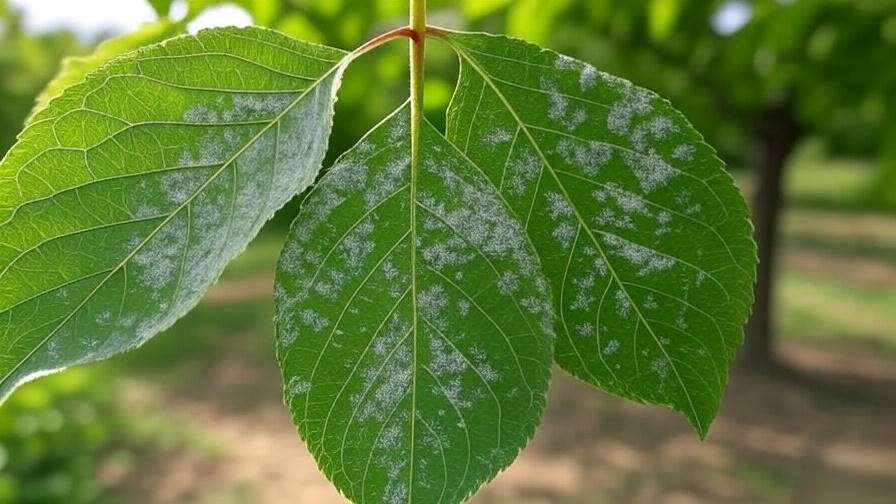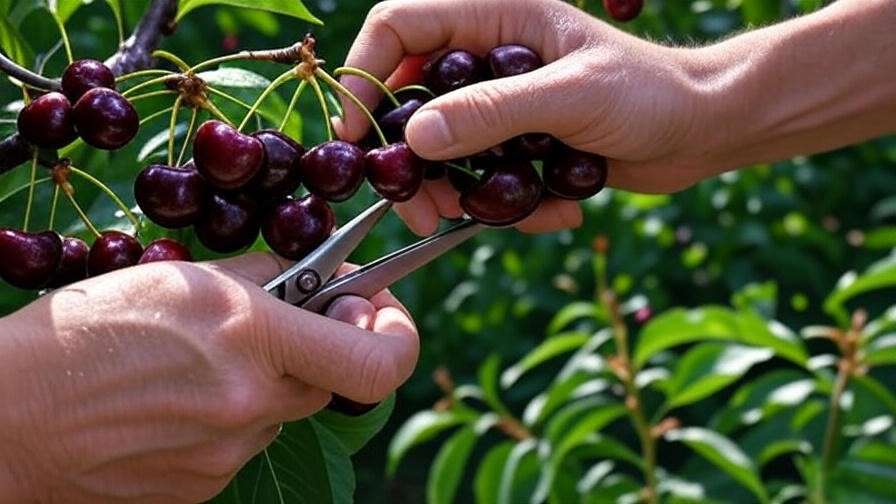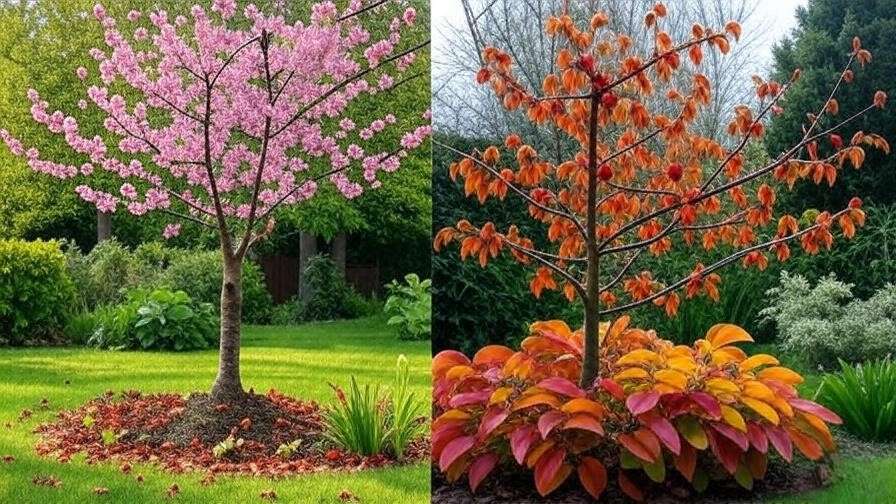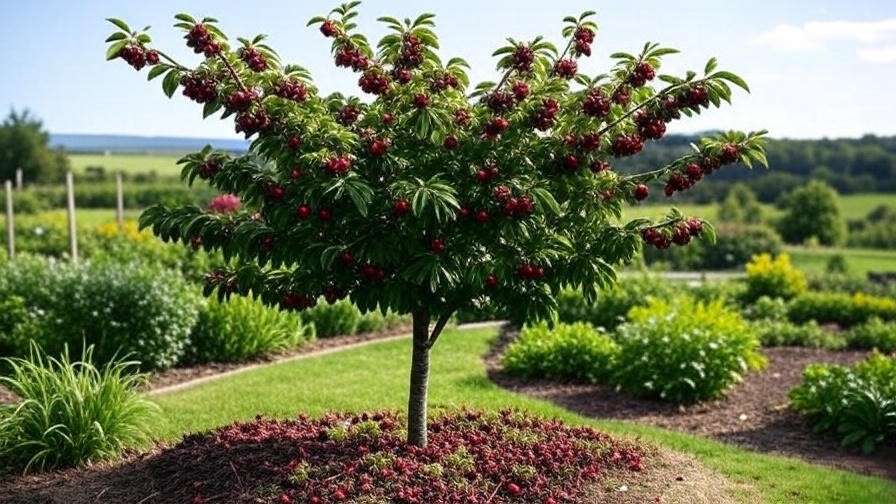Picture this: It’s a warm summer morning, and you’re strolling through your backyard, plucking sweet, juicy cherries from your very own Lapins cherry tree. The deep-red fruits burst with flavor, a reward for your care and dedication. Growing a Lapins cherry tree is a dream for many home gardeners, offering self-pollinating convenience and bountiful harvests. Whether you’re a beginner or a seasoned grower, this comprehensive guide will walk you through every step to cultivate a thriving Lapins cherry tree. From planting to harvesting, we’ve got you covered with expert tips, practical advice, and proven strategies to ensure your tree flourishes. As a horticulturist with over a decade of experience in fruit tree cultivation, I’ve seen firsthand the joy of nurturing these trees to abundance. Let’s dive in and make your cherry-growing journey a success!
1. Why Choose a Lapins Cherry Tree? 🍒
The Lapins cherry tree is a standout choice for home orchards, and for good reason. Its unique qualities make it a favorite among gardeners seeking delicious fruit with minimal fuss.
1.1. What Makes Lapins Special?
The Lapins cherry tree, developed in Canada, is a self-fertile cultivar, meaning it doesn’t require a second tree for pollination—a huge advantage for small gardens. Its large, dark-red cherries are sweet yet slightly tart, perfect for fresh eating, baking, or preserving. Hardy in USDA zones 5–9, Lapins adapts to various climates, from chilly northern regions to milder coastal areas. Compared to other varieties like Bing (which needs a pollinator) or Stella, Lapins offers higher yields and better disease resistance, especially against bacterial canker. Its compact growth, typically reaching 12–15 feet, suits both backyards and commercial orchards.
1.2. Is a Lapins Cherry Tree Right for You?
Lapins is ideal for beginners due to its low-maintenance pollination and for experienced gardeners wanting reliable harvests. Before planting, assess your space: you’ll need at least 10–15 feet of garden area with full sun. Consider your climate and time commitment—Lapins requires consistent care, especially in its early years. Expert Tip: Use this quick checklist to ensure your yard is Lapins-ready:
- ☑ At least 6–8 hours of direct sunlight daily
- ☑ Well-drained soil (no standing water)
- ☑ Space for a tree to grow 12–15 feet tall and wide
If your yard checks these boxes, you’re ready to grow a Lapins cherry tree!
2. Planting Your Lapins Cherry Tree 🌳
Proper planting sets the foundation for a healthy, productive tree. Follow these steps to give your Lapins the best start.
2.1. Choosing the Perfect Location
Lapins cherry trees thrive in full sun, requiring 6–8 hours of direct sunlight daily for optimal growth and fruit production. Choose a spot away from frost pockets—low-lying areas where cold air settles. Avoid waterlogged zones, as cherries hate “wet feet.” A south-facing slope is ideal, promoting sunlight exposure and air circulation to prevent fungal issues. If you’re in a windy area, consider a location with natural windbreaks, like a fence or hedge, to protect young trees.
2.2. Preparing the Soil
Lapins cherry trees prefer slightly acidic soil (pH 6.0–6.8) that’s fertile and loamy. Test your soil using a home kit or send a sample to your local extension service. If the pH is too high, amend with elemental sulfur; if too low, add lime. Incorporate organic matter like compost or aged manure to boost fertility and improve drainage. Expert Insight: Organic matter not only feeds the roots but also enhances soil structure, ensuring your tree absorbs nutrients efficiently for better fruit quality. Dig a hole twice as wide as the root ball and just as deep to give roots room to spread.
2.3. Planting Steps for Success
The best time to plant a Lapins cherry tree is early spring or fall, when temperatures are mild, and the tree can establish roots before extreme weather. Follow these steps:
- Dig the Hole: Make it 2 feet wide and as deep as the root ball.
- Prepare the Roots: Gently loosen any circling roots on bare-root or potted trees.
- Place the Tree: Set the tree in the hole, ensuring the graft union (a small bulge above the roots) is 2–3 inches above soil level.
- Backfill and Water: Fill with soil, tamp gently, and water deeply to settle the soil.
- Stake if Needed: Use a stake for support in windy areas, but remove it after 1–2 years to encourage strong roots.
Common Mistake to Avoid: Planting too deep can suffocate roots, so keep the graft union above ground. Tip: Water thoroughly after planting (about 1–2 gallons) to eliminate air pockets. 💧
3. Essential Care for a Thriving Lapins Cherry Tree 🌿
Consistent care ensures your Lapins cherry tree grows strong and produces abundant fruit. Here’s how to nurture it year-round.
3.1. Watering Needs
Lapins cherry trees need 1–2 inches of water per week, depending on rainfall and soil type. Young trees require more frequent watering (every 5–7 days) to establish roots, while mature trees can tolerate slightly less. Use drip irrigation or a soaker hose to deliver water directly to the root zone, avoiding wet foliage that invites disease. Check soil moisture by digging 2–3 inches down—if it’s dry, water deeply. Overwatering can cause yellowing leaves or root rot, while underwatering leads to drooping or sparse fruit. Adjust based on weather: reduce watering during rainy spells and increase during droughts.
3.2. Fertilizing for Optimal Growth
Fertilize your Lapins cherry tree in early spring, just before bud break, to support growth and fruit development. Use a balanced fertilizer (e.g., 10-10-10) at a rate of 1/2 pound per year of tree age, up to 4 pounds for mature trees. Spread it evenly around the drip line (the area under the canopy’s edge), then water thoroughly. Organic options like compost, aged manure, or fish emulsion work well for eco-conscious gardeners. Expert Tip: Avoid over-fertilizing, as excess nitrogen promotes leafy growth at the expense of fruit. Test soil annually to monitor nutrient levels and adjust as needed.
3.3. Pruning for Health and Productivity
Pruning is critical for air circulation, disease prevention, and fruit production. Prune in late winter or early spring before buds swell, using clean, sharp shears. Focus on:
- Removing dead, damaged, or diseased branches.
- Cutting back suckers (shoots from the base) and water sprouts (vertical shoots).
- Thinning crowded areas to let light penetrate the canopy.
- Shaping the tree to an open-center structure for better fruiting.

For young trees, prune lightly to establish a strong framework. Mature trees need annual maintenance to remove crossing branches and encourage new growth. Visual Aid Idea: A diagram showing proper pruning cuts can help readers visualize the process. ✂️
3.4. Mulching and Weed Control
Mulch is a game-changer for Lapins cherry trees, conserving moisture, regulating soil temperature, and suppressing weeds. Apply a 2–4 inch layer of organic mulch (wood chips, straw, or bark) around the base, extending to the drip line. Keep mulch 2–3 inches away from the trunk to prevent rot or pest issues. Replenish mulch annually in spring. Hand-pull or hoe weeds regularly, as they compete for nutrients and water. Caution: Avoid piling mulch against the trunk, as this can trap moisture and cause fungal problems.
4. Protecting Your Lapins Cherry Tree from Pests and Diseases 🐞
A healthy Lapins cherry tree can face threats from pests and diseases, but proactive measures can keep it thriving. Here’s how to identify, prevent, and treat common issues effectively.
4.1. Common Pests
Lapins cherry trees attract pests like aphids, cherry fruit flies, and spider mites, which can damage leaves, fruit, or overall tree health.
- Aphids: These tiny, sap-sucking insects cluster on new growth, causing curled leaves and stunted shoots. Control them with insecticidal soap or neem oil, applied early in the morning. Encourage natural predators like ladybugs by planting companion flowers like marigolds.
- Cherry Fruit Flies: These pests lay eggs in ripening cherries, leading to maggot-infested fruit. Use yellow sticky traps to monitor and reduce populations, and apply organic spinosad sprays during fruit development.
- Spider Mites: These microscopic pests cause stippled leaves and webbing. Rinse foliage with a strong water spray or use miticides for severe infestations.
Prevention Tip: Maintain tree vigor through proper watering and fertilizing, as stressed trees are more susceptible to pests. Regular inspections, especially in spring, help catch infestations early.
4.2. Common Diseases
Lapins cherry trees are relatively disease-resistant but can still face issues like bacterial canker, powdery mildew, and brown rot.
- Bacterial Canker: This disease causes sunken, gummy lesions on branches and trunks. Prevent it by pruning in dry weather and disinfecting tools between cuts. Copper-based fungicides can help manage outbreaks.
- Powdery Mildew: A white, powdery coating on leaves indicates this fungal issue. Improve air circulation through pruning and apply sulfur-based fungicides if needed.
- Brown Rot: This fungus affects blossoms and fruit, causing them to rot and mummify. Remove infected fruit immediately and apply fungicides during bloom and pre-harvest stages.
Expert Insight: Sanitation is key—clear fallen leaves, fruit, and debris from the base of the tree to reduce fungal spores. Always water at the soil level, not overhead, to keep foliage dry.

4.3. Bird Protection Strategies
Birds love Lapins cherries as much as you do, often pecking at fruit just as it ripens. Protect your harvest with these methods:
- Netting: Drape fine-mesh netting over the tree before cherries turn red. Secure it tightly to prevent birds from sneaking in.
- Reflective Tape: Hang shiny, reflective tape or old CDs to scare birds with light and movement.
- Decoy Feeders: Place bird feeders with alternative food sources away from the tree to distract birds.
Tip: Install protective measures early, as birds can start eyeing cherries before they’re fully ripe. Check netting regularly for trapped wildlife to ensure humane protection. 🦜

5. Harvesting and Enjoying Your Lapins Cherries 🍒
After months of care, it’s time to enjoy the fruits of your labor! Here’s how to harvest and make the most of your Lapins cherries.
5.1. When and How to Harvest
Lapins cherries are ready to pick when they’re deep red, firm, and sweet, typically in late June to early July, depending on your region. Taste a cherry to confirm ripeness—mature fruit has a perfect sweet-tart balance. Harvest in the morning when fruits are cool and firm, using scissors or pruners to snip stems and avoid tearing. Gently place cherries in a shallow basket to prevent bruising. Store fresh cherries in the refrigerator for up to 3 weeks, or freeze them for longer storage. Tip: Wash cherries just before eating to maintain freshness.

5.2. Creative Uses for Your Cherries
Lapins cherries are versatile, shining in both sweet and savory dishes. Try these ideas:
- Recipes: Bake a classic cherry pie, whip up a batch of homemade cherry jam, or toss fresh cherries into a summer salad with goat cheese and arugula.
- Preservation: Can cherries in syrup for winter treats, dry them for snacks, or make cherry cordial for gifting.
- Fun Fact: Lapins cherries’ rich flavor makes them ideal for snacking straight from the tree or adding to smoothies for a nutrient boost. Experiment with cherry-infused vinegar for a gourmet touch!
6. Troubleshooting Common Issues 🔧
Even with the best care, Lapins cherry trees can face challenges. Here’s how to diagnose and fix common problems to keep your tree healthy.
6.1. Why Isn’t My Tree Producing Fruit?
If your Lapins cherry tree isn’t fruiting, consider these factors:
- Tree Age: Young trees (under 3–5 years) may not yet be mature enough to bear fruit. Be patient and focus on building tree health.
- Poor Pollination: Although self-fertile, poor weather during bloom (e.g., heavy rain) can reduce pollination. Plant pollinator-friendly flowers nearby to attract bees.
- Nutrient Deficiency: Low nitrogen or potassium can limit fruiting. Test soil and apply a balanced fertilizer if needed.
Solution: Ensure consistent care and consider planting a second cherry variety (like Stella) to boost cross-pollination, even though it’s not required.
6.2. Addressing Leaf Drop or Yellowing
Leaf drop or yellowing can signal underlying issues:
- Overwatering: Soggy soil causes root rot, leading to yellow leaves. Check drainage and reduce watering frequency.
- Pests: Aphids or spider mites can cause leaf stress. Inspect leaves and treat as outlined in Section 4.1.
- Fungal Issues: Diseases like powdery mildew may cause leaf drop. Improve air circulation and apply fungicides if needed.
Diagnostic Guide: Dig near the roots to check soil moisture, inspect leaves for pests, and prune crowded branches to enhance airflow.
6.3. Expert Q&A
Here are answers to common reader questions, based on real-world grower experiences:
- Can I grow Lapins in a container? Yes, dwarf Lapins varieties thrive in large pots (at least 15–20 gallons) with excellent drainage. Use a high-quality potting mix and water regularly.
- Why are my cherries small? Small fruit can result from insufficient water, nutrient deficiencies, or overcrowding. Thin fruit clusters early to allow larger cherries to develop.
7. Seasonal Care Calendar for Lapins Cherry Trees 📅
A year-round care schedule keeps your Lapins cherry tree in top shape. Follow this month-by-month guide:
- Spring (March–May): Apply fertilizer, prune before bud break, and monitor for pests. Start watering as growth resumes.
- Summer (June–August): Harvest cherries, maintain consistent watering, and apply mulch to retain moisture. Watch for fruit flies and birds.
- Fall (September–November): Clean up fallen leaves to prevent disease, reduce watering, and plant new trees if desired.
- Winter (December–February): Prune dormant trees, protect roots with mulch in cold climates, and check for storm damage.
Visual Aid Idea: Download a printable care calendar from our website to stay on track!

8. FAQs About Lapins Cherry Trees ❓
- How long does it take for a Lapins cherry tree to bear fruit? Typically 3–5 years, depending on tree age, care, and climate. Dwarf varieties may fruit slightly sooner.
- Can Lapins cherry trees grow in pots? Yes, dwarf Lapins are perfect for containers. Use a large pot, ensure good drainage, and prune to maintain size.
- Do I need another cherry tree for pollination? No, Lapins is self-pollinating, but a nearby cherry tree can increase yield through cross-pollination.
- How do I protect my tree from frost? Cover with frost blankets during late spring frosts or move potted trees indoors. Avoid low-lying areas prone to frost.
9. Conclusion: Your Path to a Flourishing Lapins Cherry Tree 🌸
Growing a thriving Lapins cherry tree is a rewarding journey that transforms your backyard into a fruitful oasis. By following the expert guidance in this article—choosing the right location, planting with care, providing consistent water and nutrients, pruning strategically, and protecting against pests and diseases—you’re well on your way to enjoying abundant, delicious cherries. This self-pollinating variety makes it accessible for gardeners of all skill levels to achieve a bountiful harvest. As a horticulturist who’s nurtured countless fruit trees, I can assure you that the joy of picking your own cherries is unmatched. Start today, and let your Lapins cherry tree become a centerpiece of your garden! Share your cherry-growing experiences in the comments below, or try a new cherry recipe with your harvest. For more tree care tips, explore our website’s guides on fruit tree cultivation.













